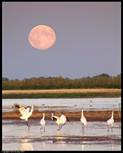by
Pam Mundo, Texas Master Naturalist, Indian Trail Chapter
 Photo taken by Chris Tyreman on September 19, 2013 @ at Radisson Lake, Radisson Saskatchewan Canada www.spaceweather.com
Photo taken by Chris Tyreman on September 19, 2013 @ at Radisson Lake, Radisson Saskatchewan Canada www.spaceweather.com
Be watchful, now is the time of the Whooping Crane migration through Texas…. reports members of the Texas Whooper Watch.
Texas Whooper Watch is a group of trained citizen scientists assisting the Texas Parks and Wildlife Department to identify the Whooping Crane migration, their stopover sites and non-traditional wintering areas. They hope to assess whether any hazards exist to whoopers at these sites and learn more about behavior and habitat use at these sites. Whooping Cranes are an endangered species with only 300 remaining in the wild. Reporting in August from Wood Buffalo National Park in Canada, scientists have found 28 families with one chick each. A typical family consists of two parents and up to two chicks. Two families successfully produced two babies for a total of 33 new chicks. The chicks and their parents with the other wild whoopers are now on a 2,500 mile trek to their wintering grounds on the Texas Coast, mostly in the Aransas Nature Refuge near Corpus Christi, TX. The Whooping Cranes officially arrive in mid-October from Canada. The flight path is a 200 miles wide corridor flying over Wichita Falls to the Texas Coast. They will stop overnight generally for short periods to feed in harvested fields or in wetlands on the edge of a lake or pond.
The whooping crane, when standing, is a 5-foot tall bird and totally white except for a red patch on the head and primary wing feathers which are black and can be seen in flight. They travel in small groups of 3 to 8. Whooping cranes can be confused with the Great Egret which is also tall. A couple quick ways to differentiate are the neck and feet. The egret flies with its neck and feet tucked in flight while the whooping crane flies with neck and feet straight out.
Besides the 300 wild whooping cranes there are experimental flocks of whooping cranes. One of the experimental flocks was raised in Louisiana from eggs taken from Canada to diversify the gene pool. We have seen these Louisiana whoopers travel from their original home in Louisiana to areas around the DFW metroplex. The behavior monitoring of this group of whooping cranes has been interesting. The original group of 7 juveniles is now two separate groups, consisting of 5 and 2 respectively, staying in different locations.
If you see whooping cranes you should stay at least 2000 feet from them and report the sighting to [email protected] . Observers are asked especially to note whether the cranes have colored leg bands on their legs.
Do you think nature should be part of our everyday life, not just somewhere to go on the weekends? You are invited to attend our free, open-to-the-public, monthly program on the fourth Monday of the month at 7 pm at the Red Oak Library, 200 Lakeview Pkwy, Red Oak, TX. For more information on the Indian Trail Master Naturalist Chapter, contact the Texas A&M AgriLife Extension Service at 972-825-5175 or visit our website at http://txmn.org/indiantrail/ .


